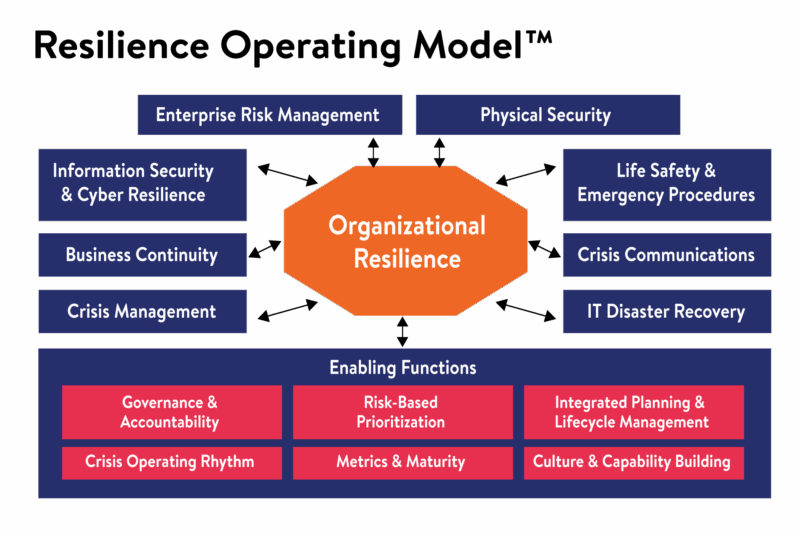Strong plans aren’t enough. Clear roles aren’t enough. Even aligned domains — business continuity, crisis, DR, comms, cyber — aren’t enough on their own.
You can have all the right capabilities and still watch your response fall apart when it matters most.
That’s because resilience doesn’t succeed with good content.
It succeeds with good systems.
These systems are what we call the Enabling Functions of the Resilience Operating Model™ — the connective tissue that makes resilience operational, not just aspirational.
From Capabilities to Coordination
In our previous article, we broke down the eight Core Domains of Resilience — the foundational capabilities that must work together.
But simply aligning domains is not enough. They need rhythm. Governance. Decision-making protocols. Accountability. The muscle memory to operate under pressure.
That’s where the Enabling Functions come in.
They take structure and turn it into system.
Resilience doesn’t fail because you didn’t have a plan.
It fails because your system wasn’t set up to run it.
Why These Functions Matter
In our work across dozens of resilience assessments, we’ve seen this repeatedly:
- Good crisis plan, but no escalation protocol
- Well-run BC program, but no executive visibility
- Capable DR teams, but no shared cadence with the business
- Playbooks on paper, but no one trained to use them
Without the right enabling functions, resilience exists in silos.
With them, it becomes continuous, measurable, and scalable.
The 6 Enabling Functions of the Resilience Operating Model™
These aren’t side elements — they’re what make the whole system work.
1. Governance
Who owns resilience? Who activates? Who escalates? Who signs off?
Without clear governance, decision-making becomes political, inconsistent, and slow.
This function defines authority, accountability, and how resilience connects to executive and board-level oversight.
2. Operating Cadence
Resilience isn’t an annual plan review. It’s a rhythm.
This function establishes how often your teams connect, update, review, test, and improve — with the business, not just within resilience teams.
It keeps the system alive.
3. Escalation & Decision-Making
Not every event is a crisis — but some escalate quickly.
This function defines how that escalation happens, who’s involved, and what protocols guide the shift from incident to full organizational response.
It creates confidence across teams that someone is in charge — and that the process is clear.
4. Metrics & Maturity
If you can’t measure it, you can’t manage it.
This function tracks performance — not just activity — through test results, recovery objectives, readiness indicators, and maturity benchmarking.
It also helps answer the board’s most important question: “Are we ready?”
5. Training & Exercises
Exercises aren’t check-the-box events.
They’re where resilience gets tested, stress gets exposed, and muscle memory gets built.
This function ensures exercises are integrated, realistic, and focused on decision-making — not just compliance.
It also provides targeted training for every level of the organization, from executive leadership to frontline responders.
6. Culture & Capability Building
Resilience isn’t just technical — it’s behavioral.
This function embeds resilience into how your organization thinks, leads, and operates.
It includes leadership mindset, after-action discipline, incentive structures, and the ability to evolve.
What Happens When They’re Missing
Here’s what we see when these functions aren’t in place:
- Escalation happens via informal texts and Slack messages — not structure
- Exercises test one domain at a time, with no coordination
- Reports track how many plans exist — but not how ready the business actually is
- Training is generic, misaligned, or skipped entirely
- Resilience lives on the edge of the business, not in its core
You can have great plans. Talented teams. Strong intent.
But if the system isn’t built to operate — it won’t.
A Resilience Operating Model™ without enabling functions is a framework without a heartbeat.
How the Resilience Operating Model™ Brings These Together

The Resilience Operating Model™ is not just a map of your capabilities — it’s the engine that runs them.
These enabling functions provide structure and rhythm.
They ensure your response is coordinated.
They build accountability into planning, testing, and improvement.
They create space for continuous learning — without waiting for a crisis to expose the gaps.
Together, they turn your resilience from static to dynamic.
From isolated to integrated. From hopeful to high-performing.
→ Explore the full Resilience Operating Model™️ Report
Want to work with us or learn more about Resilience?
- Our proprietary Resiliency Diagnosis process is the perfect way to advance your business continuity program. Our thorough standards-based review culminates in a full report, maturity model scoring, and a clear set of recommendations for improvement.
- Our Business Continuity and Crisis Management services help you rapidly grow and mature your program to ensure your organization is prepared for the storms that lie ahead.
- Our Ultimate Guide to Business Continuity contains everything you need to know about Business Continuity while our Ultimate Guide to Crisis Management contains the same for Crisis Management.
- Learn about our Free Resources, including articles, a resource library, white papers, reports, free introductory courses, webinars, and more.
- Set up an initial call with us to chat further about how we might be able to work together.


 The 8 Core Domains of Resilience: What Every Organization Must Align
The 8 Core Domains of Resilience: What Every Organization Must Align